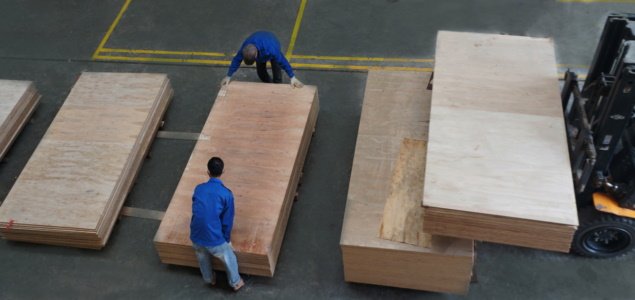Vietnam’s wood industry, a key sector of the economy, has faced severe disruptions in the aftermath of Typhoon Yagi. This super typhoon has not only caused extensive damage to infrastructure and raw material sources but also crippled supply chains, leaving businesses in the wood industry struggling to meet international demands. With a projected loss of $1.64 billion and a potential 0.15% drop in Vietnam’s GDP for 2024, the storm’s aftermath emphasizes the importance of building a more resilient supply chain to withstand future environmental challenges.
The Immediate Aftermath of Typhoon Yagi on Vietnam’s Wood Industry
Typhoon Yagi, which hit Vietnam’s northern provinces, caused widespread damage across multiple industries, but none were as affected as the wood industry. Power outages, damaged goods, transportation blockages, and logistical disruptions have been widespread, leaving 82.4% of businesses facing major disruptions, according to a survey by CEL, a leading supply chain consultancy.
The damage goes beyond the immediate effects. The storm has exposed vulnerabilities in Vietnam’s wood supply chain, highlighting the urgent need for industry-wide adaptation to better prepare for future natural disasters.
Damage to Raw Material Sources: A Threat to Timber Supply
One of the most significant challenges faced by Vietnam’s wood industry post-Typhoon Yagi is the extensive damage to reforestation and wood harvesting areas. Heavy rainfall, landslides, and flooding caused severe destruction in timber-producing regions, drastically affecting the available raw material supply.
This depletion of timber supply not only affects the current export capacity but also presents long-term challenges for forest regeneration. The reforestation efforts necessary to restore these areas will take years, leaving the wood industry vulnerable to shortages for the foreseeable future. The damages have created significant disruptions in the supply chain, making it difficult for companies to collect and process raw timber needed to meet the demands of international markets.
Compounding the problem is the damage to the road and bridge infrastructure that connects these forestry areas to processing plants. Many of the roads were washed away or rendered impassable by landslides, further delaying the transportation of wood from the forests to processing facilities and export terminals. These bottlenecks are delaying production and shipments, causing significant financial losses for wood exporters.
Logistics Breakdown: Delayed Wood Exports and Blocked Transportation
Typhoon Yagi’s impact on Vietnam’s logistics infrastructure has been equally devastating. The typhoon caused severe damage to Vietnam’s road networks, seaports, and key transportation routes essential for exporting wood products. Delays in transportation meant that wood exports were delayed, missing critical delivery deadlines to international partners.
For businesses that rely on time-sensitive deliveries, these delays have serious consequences. Delayed shipments affect contracts, damage relationships with international buyers, and ultimately lead to financial penalties. While 44.6% of surveyed companies expect to recover within 1-2 weeks, this optimistic projection may not be realistic for all businesses. According to Julien Brun, managing partner of CEL, unforeseen challenges may lead to longer recovery times.
The cold chain supply and third-party logistics (3PL) providers were also severely impacted by the storm. The delay in transportation has created bottlenecks in the supply chain, putting strain on the entire wood export ecosystem. The delays at ports, road closures, and the temporary suspension of certain transport services due to unsafe conditions have contributed to an overall slowdown in the industry’s recovery.
The Need for Supply Chain Resilience
The damage caused by Typhoon Yagi has sent a clear message to Vietnam’s wood industry: supply chain resilience is no longer an option, it is a necessity. Julien Brun of CEL emphasized that the era of predictable weather patterns is over. Typhoon Yagi is a stark reminder that businesses must adapt to the growing frequency and intensity of natural disasters caused by climate change.
Resilient supply chains must be designed to withstand these unpredictable events. This means creating redundancies, diversifying transportation networks, and improving infrastructure in vulnerable areas. Businesses need to invest in advanced forecasting tools to better anticipate weather-related disruptions and respond with agility.
In addition, strengthening partnerships between public and private sectors will be crucial in accelerating recovery efforts. Government initiatives to improve infrastructure, coupled with industry efforts to better manage risk, will be vital to building a more robust supply chain capable of bouncing back from future disruptions.
Recovery Efforts: Moving Forward After Typhoon Yagi
Despite the immense challenges, there are efforts underway to recover from the damage. Local authorities, in partnership with businesses, are working to mobilize resources quickly to restore operations. Emergency repairs to roads, seaports, and bridges are being prioritized to resume the flow of goods and restore export activities.
However, recovery is not just about repairing damaged infrastructure. For the wood industry, recovery also means rebuilding relationships with international partners, ensuring that contracts are honored, and proving that Vietnam remains a reliable supplier of wood products, even in the face of natural disasters.
Moving forward, the industry must adopt new technologies to improve operational efficiency and better predict weather-related risks. Supply chain management software, real-time tracking systems, and early warning systems for natural disasters can all play a role in minimizing the impact of future disruptions.
Conclusion: A Wake-Up Call for the Wood Industry
The aftermath of Typhoon Yagi has exposed the vulnerabilities in Vietnam’s wood industry supply chain, showing that natural disasters can no longer be treated as rare occurrences. Businesses must act now to build resilience into their operations, from improving infrastructure to diversifying raw material sources and adopting advanced risk management technologies.
Vietnam’s wood industry, though hard-hit, has the opportunity to emerge stronger by learning from this disaster. The focus must now shift towards creating a supply chain that can adapt and thrive, even in the face of increasingly unpredictable environmental challenges.
You can read more articles by visiting our blog here.









